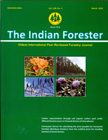Management of Degraded Bouldery Riverbed Lands through Paulownia Based Silvipastoral Systems in Doon Valley
DOI:
https://doi.org/10.36808/if/2012/v138i3/4620Abstract
The field experiment was conducted during the year 2001 to 2006 on marginal degraded bouldery riverbed lands of Doon Valley in North-West India under rainfed conditions. The performance of grasses viz Panicum maximum (fodder grass) and Eulaliopsis binata (industrial grass for fibre and paper pulp) was evaluated alone and in association with Paulownia fortunei with regard to growth parameters and biomass yield. Seventy five per cent lower portion of the tree crown was lopped every year in the month of October - November to obtain different forms of usable biomass (leaf fodder + fuel wood). The maximum height before lopping of the Paulownia tree was recorded 7.6 m with 17.7 cm Diameter at Breast Height (DBH) in the silvipastoral system, which produced 41.9, 55.6 and 97.5 qDownloads
Download data is not yet available.
Downloads
Published
2012-03-01
How to Cite
Singh, C., Dadhwal, K. S., Dhiman, R. C., & Kumar, R. (2012). Management of Degraded Bouldery Riverbed Lands through <I>Paulownia</I> Based Silvipastoral Systems in Doon Valley. Indian Forester, 138(3), 243–247. https://doi.org/10.36808/if/2012/v138i3/4620
Issue
Section
Articles
License
Unless otherwise stated, copyright or similar rights in all materials presented on the site, including graphical images, are owned by Indian Forester.





